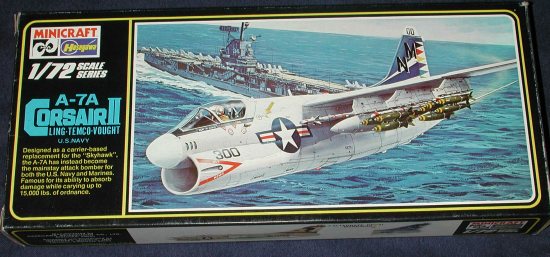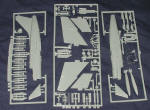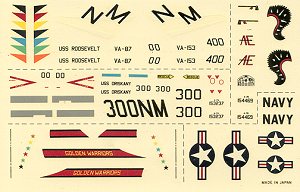
| KIT: | Hasegawa 1/72 A-7A Corsair II |
| KIT #: | 013 |
| PRICE: | $? |
| DECALS: | Two options |
| REVIEWER: | Scott Van Aken |
| NOTES: | First generation Hasegawa kit |

| HISTORY |
The Corsair II was designed as a lightweight attack aircraft to supplement and later replace the Douglas A-4 Skyhawk. In addition to service in our Navy, Corsair II's were flown by our Air Force, Air National Guard, and several other nations. The Ling· Temco-Vought A-7 production line started on 19 March 1964 and continued until September 1984; 1,545 were built. Its first flight, powered by a Pratt & Whitney TF3O-P-6 turbofan engine, was on 27 September 1965. Navy Preliminary Evaluations were underway in January 1966. Test programs were accomplished with wartime urgency, and the first fleet delivery (VA-174) was on 14 October 1966. Retirement of the last two Navy A-7 aircraft fleet operational squadrons (VA-46 and VA-72) was in May 1991 after their service in Desert Storm.
| THE KIT |
 Well,
this is one of Hasegawa's first generation kits. By that, I mean that it is
raised panel lines, rivets where needed, minimal interior and wheel well
detail and if it carries stores, they are somewhat crude. However, back
when it was produced, it was gobbled up along with Hasegawa's other US Navy
aircraft as they were a TON better than what was being produced by the
other guys.
Well,
this is one of Hasegawa's first generation kits. By that, I mean that it is
raised panel lines, rivets where needed, minimal interior and wheel well
detail and if it carries stores, they are somewhat crude. However, back
when it was produced, it was gobbled up along with Hasegawa's other US Navy
aircraft as they were a TON better than what was being produced by the
other guys.
You might expect this one to have a
rather short intake and you'd be correct. Equally correct is the short, but
not bad exhaust. The wing pylons are fitted for the appropriate things
under wings, in this case, drop tanks inboard, MER on the center pylon and
TER on the outer one. These are just facsimiles of the real thing, though
the drop tanks are presentable. Two Sidewinders are provided for the
forward fuselage. Hasegawa thoughtfully predrilled these holes so if you
don't want them, break out the filler. Unusually, it has a separate speed
brake, which you can droop a bit on the ground if you want to provide some
sort of detail for the brake well. Wheels are fair but still not what the
real plane carried. You also have to deal
 with ejector pin marks on
most everything. There is a two piece canopy/windscreen combo to show off
your generic seat and pilot figure as there are no other interior parts
around. A decal is provided for an instrument panel.
with ejector pin marks on
most everything. There is a two piece canopy/windscreen combo to show off
your generic seat and pilot figure as there are no other interior parts
around. A decal is provided for an instrument panel.
Instructions are what we had come to expect from Hasegawa back then. Five construction steps on one side of a sheet with a commentary to accompany it. Some color info is provided during the construction steps along with FS 595 colors where appropriate. Markings are for two aircraft, all in light gull grey over white. First up is the box art plane of VA-153 aboard the USS Oriskany. This is a nice, CAG bird. Next is another CAG bird from VA-87 aboard the FDR. Decals are well printed, thick and the white is actually ivory (which blends in perfectly with the backing). Despite their age, I'm sure they would work just fine
| CONCLUSIONS |
While eclipsed by the Fujimi kit in nearly every way, this old Hasegawa kit is often found for a very reasonable price and is basically quite good in outline. If you want a non-fussy build, then you might suggest grabbing one of these.
Review kit courtesy of your editor
If you would like your product reviewed fairly and fairly quickly by a site that has over 250,000 visitors a month, please contact me or see other details in the Note to Contributors.